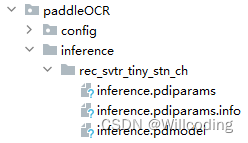前言
PaddleOCR是百度飞桨开源的超轻量级文字识别模型套件,包含数十种文本检测、识别模型。
在这之前我们已经使用torchserver完成了对文本检测模型DBNet的服务化部署,对于文本识别,选择使用PaddleOCR中的SVTR模型:场景文本识别算法SVTR,最后串联这两个模型获取输入文件完整的文本内容。
PaddleOCR的服务化部署
关于paddle模型的推理部署方式,官网给出了各种解决方案:,https://github.com/PaddlePaddle/PaddleOCR/blob/main/deploy/README_ch.md
这里我们以Paddle2ONNX转换模型文件,然后用triton-inference-server进行部署,并重点介绍如何使用部署之后生成的对外接口,包括预处理、调用模型接口、后处理
模型文件
SVTR识别模型可以直接使用,也可以根据官方提供的方案自己训练,将训练好的权重转换为inference_model,转换之后的目录包含三个文件:
/inference/rec_svtr_tiny_stn_ch/
├── inference.pdiparams # 识别inference模型的参数文件
├── inference.pdiparams.info # 识别inference模型的参数信息,可忽略
└── inference.pdmodel # 识别inference模型的program文件

可直接用于推理
python3 tools/infer/predict_rec.py --image_dir='./example/images/test.png' --rec_model_dir='./inference/rec_svtr_tiny_stn_ch/' --rec_algorithm='SVTR' --rec_image_shape='3,64,256' --rec_char_dict_path='./ppocr/utils/ppocr_keys_v1.txt'
模型转换
Open Neural Network Exchange (ONNX) 是机器学习模型机和深度学习模型的开放标准化格式。 可以从 TensorFlow、PyTorch、Scikit-learn、Keras 和 SparkML 等框架转换模型。
使用 ONNX 的主要优势在于不同的平台和框架都会接受该标识,以便更轻松地优化模型的性能。
Paddle2ONNX 支持将 PaddlePaddle 模型格式转化到 ONNX 模型格式。
- 安装
pip install paddle2onnx -i https://pypi.tuna.tsinghua.edu.cn/simple
- 转换
paddle2onnx --model_dir rec_svtr_tiny_stn_ch \
--model_filename model.pdmodel \
--params_filename model.pdiparams \
--save_file model.onnx \
--enable_dev_version True
执行完毕后,即得到ONNX模型model.onnx。目录结构如下:
/inference/rec_svtr_tiny_stn_ch/
├── inference.pdiparams
├── inference.pdiparams.info
├── inference.pdmodel
└── paddleOCR
└── 1
└── model.onnx
部署
因为我们的团队有许多类似的模型,为方便统一部署和管理,选择了Triton Inference Server。
NVIDIA Triton 推理服务器是 NVIDIA AI 平台的一部分,它是一款开源推理服务软件,可助力标准化模型的部署和执行,并在生产环境中提供快速且可扩展的 AI。支持 TensorFlow、NVIDIA® TensorRT™、PyTorch、ONNX Runtime 等所有主流框架,同时支持定制后端框架。可并行运行多个模型以提高吞吐量和利用率。
- 获取
通过源码中的脚本获取,或者直接通过docker拉取镜像,详细教程参考triton-quickstart,这里不做过多赘述。 - 运行
tritonserver --model-repository=/paddleOCR/inference/rec_svtr_tiny_stn_ch/
接下来我们就可以通过对外接口调用模型进行推理了。
预处理
经triton部署的模型必须指定名称、数据类型和输入维度。

我们输入的图片维度是动态的,因此需要根据不同场景指定识别图片的大小,得到统一的维度,本章模型指定的维度为(1,3,64,256),然后将处理后的图片转成二进制格式。
def preprocess(image_file):
img = cv2.imread(image_file)
rec_image_shape = 3, 64, 256
imgC, imgH, imgW = rec_image_shape
norm_img = cv2.resize(
img, (imgW, imgH), interpolation=cv2.INTER_LINEAR)
norm_img = norm_img.astype('float32')
norm_img = norm_img.transpose((2, 0, 1)) / 255
norm_img -= 0.5
norm_img /= 0.5
norm_img = norm_img[np.newaxis, :]
norm_img = norm_img.copy()
# 调用模型
image_buffer = norm_img.tobytes()
return image_buffer
调用模型
指定输入数据的结构和参数,调用模型。代码实现:
def paddleOCR_rec(image_buffer):
raw_data = {
"inputs": [{
"name": "x",
"datatype": "FP32",
"shape": [1, 3, 64, 256],
"parameters": {
"binary_data_size": len(image_buffer)
}
}],
"outputs": [{
"name": "softmax_12.tmp_0",
"datatype": "FP32",
"shape": [1, 40, 6625],
"parameters": {
"binary_data": False
}
}]
}
request_buffer = json.dumps(raw_data).encode()
data = request_buffer + image_buffer
header = {
"Content-Type": "application/octet-stream",
"Accept": "*/*",
"Inference-Header-Content-Length": str(len(request_buffer)),
"Content-Length": str(len(image_buffer) + len(request_buffer))
}
url = "https://[接口地址]/models/paddleOCR/versions/1/infer/"
response = requests.post(url=url, data=data, headers=header)
return response
参数详解
raw_data定义了模型的输入和输出结构,其中输出的shape:[1, 40, 6625]代表文本内容的映射。6625指的是模型指定字典文件的大小,
字典文件:ppocr_keys_v1.txt,文件来源:https://github.com/PaddlePaddle/PaddleOCR/blob/main/ppocr/utils
- 文本映射
使用argmax函数,在40个映射向量中分别找到最大元素的索引,索引区间为[0, 6624],得到维度为(1, 40)的向量,其中的非零数字在字典文件中的映射,一一对应识别结果,0对应字典文件中的“blank”,手动跳过。例如,4245、4547、3332分别对应字典文件中的字母“o”、“n”、“e”,于是得到结果为“one”。 - 置信度映射
同时,使用max函数,在40个映射向量中分别找到最大元素的值,对应的是每个输出结果的置信度,同步进行查询得到最后的文本,取平均数作为最终文本内容的置信度。
以上操作在后处理部分实现。
后处理
def decode(text_index, text_prob=None, is_remove_duplicate=True):
""" convert text-index into text-label. """
result_list = []
ignored_tokens = [0]
batch_size = len(text_index)
character_str = []
with open("./ppocr_keys_v1.txt", "rb") as fin:
lines = fin.readlines()
for line in lines:
line = line.decode('utf-8').strip("\n").strip("\r\n")
character_str.append(line)
character_str.append(" ")
dict_character = list(character_str)
character = ['blank'] + dict_character
for batch_idx in range(batch_size):
selection = np.ones(len(text_index[batch_idx]), dtype=bool)
if is_remove_duplicate:
selection[1:] = text_index[batch_idx][1:] != text_index[
batch_idx][:-1]
for ignored_token in ignored_tokens:
selection &= text_index[batch_idx] != ignored_token
char_list = [character[text_id] for text_id in text_index[batch_idx][selection]]
if text_prob is not None:
conf_list = text_prob[batch_idx][selection]
else:
conf_list = [1] * len(selection)
if len(conf_list) == 0:
conf_list = [0]
text = ''.join(char_list)
result_list.append({
"result": text,
"confidence": np.mean(conf_list).tolist()
})
return result_list
def postprocess(response):
pred = np.array(response.json()["outputs"][0]['data'])
preds = pred.reshape(1, 40, 6625)
preds_idx = preds.argmax(axis=2)
preds_prob = preds.max(axis=2)
rec_result = decode(preds_idx, preds_prob, is_remove_duplicate=True)
return json.dumps(rec_result)
示例

- 识别结果
[{"result": "onecard", "confidence": 0.9846975037029811}]
完整代码
import json
import cv2
import requests
import numpy as np
def preprocess(image_file):
img = cv2.imread(image_file)
rec_image_shape = 3, 64, 256
imgC, imgH, imgW = rec_image_shape
norm_img = cv2.resize(
img, (imgW, imgH), interpolation=cv2.INTER_LINEAR)
norm_img = norm_img.astype('float32')
norm_img = norm_img.transpose((2, 0, 1)) / 255
norm_img -= 0.5
norm_img /= 0.5
norm_img = norm_img[np.newaxis, :]
norm_img = norm_img.copy()
# 调用模型
image_buffer = norm_img.tobytes()
return image_buffer
def paddleOCR_rec(image_buffer):
raw_data = {
"inputs": [{
"name": "x",
"datatype": "FP32",
"shape": [1, 3, 64, 256],
"parameters": {
"binary_data_size": len(image_buffer)
}
}],
"outputs": [{
"name": "softmax_12.tmp_0",
"datatype": "FP32",
"shape": [1, 40, 6625],
"parameters": {
"binary_data": False
}
}]
}
request_buffer = json.dumps(raw_data).encode()
data = request_buffer + image_buffer
header = {
"Content-Type": "application/octet-stream",
"Accept": "*/*",
"Inference-Header-Content-Length": str(len(request_buffer)),
"Content-Length": str(len(image_buffer) + len(request_buffer))
}
url = "https://[接口地址]/models/paddleOCR/versions/1/infer/"
response = requests.post(url=url, data=data, headers=header)
return response
# 后处理
def decode(text_index, text_prob=None, is_remove_duplicate=True):
""" convert text-index into text-label. """
result_list = []
ignored_tokens = [0]
batch_size = len(text_index)
# "--rec_char_dict_path",
# type=str,
# default="./ppocr/utils/ppocr_keys_v1.txt"
# --use_space_char", type=str2bool, default=True
character_str = []
with open("./ppocr_keys_v1.txt", "rb") as fin:
lines = fin.readlines()
for line in lines:
line = line.decode('utf-8').strip("\n").strip("\r\n")
character_str.append(line)
character_str.append(" ")
dict_character = list(character_str)
character = ['blank'] + dict_character
for batch_idx in range(batch_size):
selection = np.ones(len(text_index[batch_idx]), dtype=bool)
if is_remove_duplicate:
selection[1:] = text_index[batch_idx][1:] != text_index[
batch_idx][:-1]
for ignored_token in ignored_tokens:
selection &= text_index[batch_idx] != ignored_token
char_list = [character[text_id] for text_id in text_index[batch_idx][selection]]
if text_prob is not None:
conf_list = text_prob[batch_idx][selection]
else:
conf_list = [1] * len(selection)
if len(conf_list) == 0:
conf_list = [0]
text = ''.join(char_list)
result_list.append({
"result": text,
"confidence": np.mean(conf_list).tolist()
})
return result_list
def postprocess(response):
pred = np.array(response.json()["outputs"][0]['data'])
preds = pred.reshape(1, 40, 6625)
preds_idx = preds.argmax(axis=2)
preds_prob = preds.max(axis=2)
rec_result = decode(preds_idx, preds_prob, is_remove_duplicate=True)
return json.dumps(rec_result)
if __name__ == '__main__':
import argparse
parser = argparse.ArgumentParser(description='Script to paddleOCR.')
parser.add_argument('--image_file', type=str, default="../example/images/en.png", help='')
params = parser.parse_args()
image_buffer = preprocess(params.image_file)
response = paddleOCR_rec(image_buffer)
rec_result = postprocess(response)
print("rec_result:", rec_result)
欢迎指正补充!








 本文介绍了如何使用PaddleOCR的SVTR模型进行服务化部署,包括模型转换为ONNX格式,通过TritonInferenceServer进行推理,并详细说明了预处理、调用模型接口和后处理步骤。
本文介绍了如何使用PaddleOCR的SVTR模型进行服务化部署,包括模型转换为ONNX格式,通过TritonInferenceServer进行推理,并详细说明了预处理、调用模型接口和后处理步骤。














 1600
1600











 被折叠的 条评论
为什么被折叠?
被折叠的 条评论
为什么被折叠?








